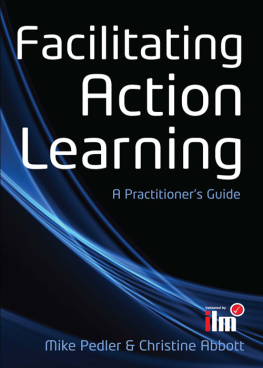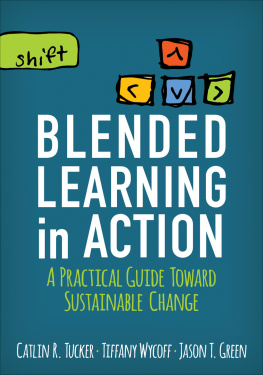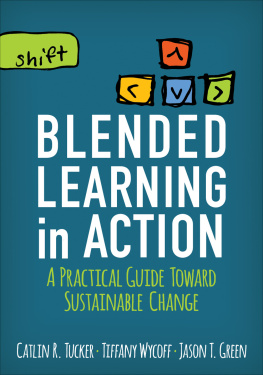Garvin - Learning in action: a guide to putting the learning organization to work
Here you can read online Garvin - Learning in action: a guide to putting the learning organization to work full text of the book (entire story) in english for free. Download pdf and epub, get meaning, cover and reviews about this ebook. City: Boston, year: 2000, publisher: Harvard Business Review Press, genre: Business. Description of the work, (preface) as well as reviews are available. Best literature library LitArk.com created for fans of good reading and offers a wide selection of genres:
Romance novel
Science fiction
Adventure
Detective
Science
History
Home and family
Prose
Art
Politics
Computer
Non-fiction
Religion
Business
Children
Humor
Choose a favorite category and find really read worthwhile books. Enjoy immersion in the world of imagination, feel the emotions of the characters or learn something new for yourself, make an fascinating discovery.
Learning in action: a guide to putting the learning organization to work: summary, description and annotation
We offer to read an annotation, description, summary or preface (depends on what the author of the book "Learning in action: a guide to putting the learning organization to work" wrote himself). If you haven't found the necessary information about the book — write in the comments, we will try to find it.
Garvin: author's other books
Who wrote Learning in action: a guide to putting the learning organization to work? Find out the surname, the name of the author of the book and a list of all author's works by series.
Learning in action: a guide to putting the learning organization to work — read online for free the complete book (whole text) full work
Below is the text of the book, divided by pages. System saving the place of the last page read, allows you to conveniently read the book "Learning in action: a guide to putting the learning organization to work" online for free, without having to search again every time where you left off. Put a bookmark, and you can go to the page where you finished reading at any time.
Font size:
Interval:
Bookmark:
Learning
in Action
in Action
A GUIDE TO PUTTING
THE LEARNING ORGANIZATION
TO WORK
HARVARD BUSINESS REVIEW PRESS
Boston, Massachusetts
Copyright 2000 David A. Garvin
All rights reserved
Printed in the United States of America
Library of Congress Cataloging-in-Publication Data
Garvin, David A.
Learning in action : a guide to putting the learning organization to work /
David A. Garvin.
p.cm.
Includes bibliographical references and index.
ISBN 978-1-59139-1906 (alk. paper)
1. Organizational learning. 2. Organizational learning-Case studies. I. Title.
HD58.82 .G37 2000
658.406dc21 99048911
To my parents,
who taught me to love learning,
and to my wife and daughters,
who keep me learning every day
By now the value of organizational learning is widely recognized. Managers view knowledge as a key corporate asset, to be leveraged and exploited for competitive purposes. They see best practices as sources of superior productivity and growth, to be disseminated as quickly as possible. They consider creative ideas and innovative thinking essential to success in emerging, rapidly changing markets. For all of these reasons, it is hard to find a manager today who does not give at least lip service to the importance of building a learning organization.
Yet despite this apparent acceptance, progress has been slow. Learning organizations have been embraced in theory but are still surprisingly rare. Managers find them easy to imagine but hard to create and sustain. The reason, in large part, is the lack of guidelines for practice. Past discussions of the subject have paid little or no attention to the gritty details of implementation. They have presented a compelling case for learning and painted a tempting picture of the desired endpoint but have left many questions unanswered. Most are operational and action oriented: How do I, as a manager, get started? What tools and techniques must I master? What processes must be in place? When and how is each approach best used? What do I need to do personally to lead the learning process? And how will I know when my company has truly become a learning organization?
The aim of this book is to provide answers to these questions and, in the process, to help managers build more effective learning organizations. The analysis that follows has four distinguishing features. First, it is comprehensive and synthetic. In exploring the landscape of learning, I have drawn on research from many fields, including anthropology, cognitive science, economics, education, engineering, management, organization theory, philosophy, political science, and psychology. My goal is to provide a broad, integrated view of the topic that is grounded in scholarship. Much of the evidence I cite has deep practical importance yet has never before been assembled in one place or translated into terms that are accessible to managers. Together, the findings from these studies present a compelling picture of the drivers of organizational learning, the practices that contribute to success and failure, and the behaviors required of managers and employees.
Second, the book is filled with a wealth of examples. They take two forms: detailed case studies and brief snapshots. The case studies provide in-depth profiles of successful learning processes at organizations such as Xerox, L.L. Bean, the U.S. Army, GE, Timken, and Allegheny Ludlum Steel. They are based on extensive field research and include a wide range of quotations, tips and techniques, instructions, and lists of dos and donts. Each is a complete, composite picture of learning in action. The snapshots are more tightly focused; each singles out a particularly effective program or policy or else highlights an error that could be easily avoided. They do not attempt to present a complete learning story. But they do broaden the range of companies covered and show how learning can be applied in extremely diverse settings. Among the companies featured are Banc One, Boeing, British Petroleum, Corning, Disney, Emerson Electric, Intel, Microsoft, Motorola, Nike, Pepsi, Target, Time Life, and Wal-Mart, as well as a host of lesser-known firms.
Third, the book has a distinctive point of view. I argue that at the heart of organizational learning lies a set of processes that can be designed, deployed, and led. These processes need not be left to chance. They canand, according to the main argument of the book, shouldbe managed. This is not to suggest that learning always arrives through planning or systematic analysis. Serendipityin the form of unexpected connections or unanticipated eventsclearly plays a role. The focus here, however, is on increasing the odds of success and improving the breadth, depth, and speed of learning by following well-crafted processes and procedures. Learning will always remain something of an art, but even the best artists can improve their technique.
Fourth, and perhaps most important, the book has a strong practical bent. Many managers remain uncomfortable with the soaring, high-minded prose of past discussions of organizational learning. They are driven by far more immediate concerns. Their focusand the one that I have adopted in this bookis getting things done. Whenever a critical learning process is described, it is accompanied by a concrete discussion of the policies, programs, and procedures that are required for success. Whenever a tool or technique is featured, it is accompanied by a set of instructions for applying it in real organizations. Whenever a mind-set or environment is cited as conducive to learning, it is accompanied by a list of supporting steps and activities. And whenever the challenge of leading learning is discussed, it is accompanied by specific suggestions for creating opportunities, sharing knowledge, setting the proper tone, and shaping the discussion process.
The book is divided into suggests ways that they can best be overcome. The chapter concludes with a discussion of the defining characteristics of supportive learning environments and presents examples of policies and programs that encourage them.
The second section, which consists of for success are then discussed, and several variations or alternative approaches are examined. Each major alternative is accompanied by an extended case study that shows the process in action.
Together, these three chapters present a set of processes that collectively provide companies with virtually all they need to know to create a learning organization. The processes fit together neatly, since each has a different orientation. Intelligence gathering is aimed at the present; it ensures that organizations attend to currently available information. Experiential learning is aimed at the past; it ensures that organizations draw lessons from activities that have already taken place. Experimentation is aimed at the future; it ensures that organizations look ahead, trying out new designs or theories to test their validity. Present, past, and futurethe coverage is comprehensive and complete.
The final section of the book, which consists of If they hope to build learning organizations, they too must become more open to divergent views, more aware of their personal biases, and more comfortable with raw, unfiltered data. Otherwise, they will never be able to lead others in learning.
Throughout, the book is guided by a simple premise: learning organizations are built from the gritty details of practice. Sweeping metaphors and grand themes are far less helpful than the knowledge of how individuals and organizations learn on a daily basis. The key to success is mastery of the details, coupled with a command of the levers that shape behavior. This book shows managers how they can use that understanding to create learning organizations that work.
Next pageFont size:
Interval:
Bookmark:
Similar books «Learning in action: a guide to putting the learning organization to work»
Look at similar books to Learning in action: a guide to putting the learning organization to work. We have selected literature similar in name and meaning in the hope of providing readers with more options to find new, interesting, not yet read works.
Discussion, reviews of the book Learning in action: a guide to putting the learning organization to work and just readers' own opinions. Leave your comments, write what you think about the work, its meaning or the main characters. Specify what exactly you liked and what you didn't like, and why you think so.








